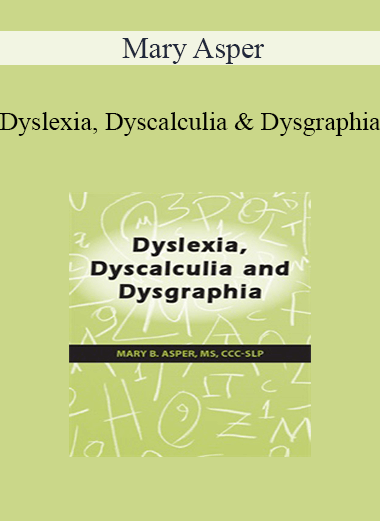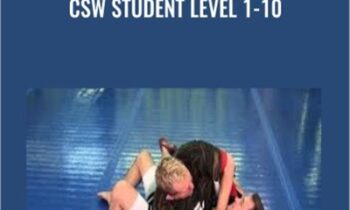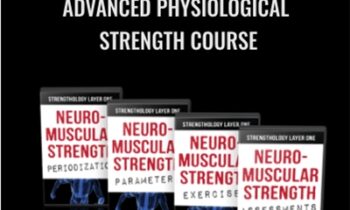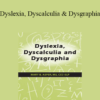$219.99 Original price was: $219.99.$36.00Current price is: $36.00.
 Purchase this course you will earn 36 Points worth of $3.60
Purchase this course you will earn 36 Points worth of $3.60Elevate your skills with the Mary Asper – Dyslexia, Dyscalculia and Dysgraphia course, available for just $219.99 Original price was: $219.99.$36.00Current price is: $36.00. on Utralist.com! Browse our curated selection of over 60,000 downloadable digital courses across diverse Health and Medical. Benefit from expert-led, self-paced instruction and save over 80%. Start learning smarter today!
Salepage link: At HERE. Archive:
Total sizes: – include:
- Faculty:
- Mary Asper
- Duration:
- 6 Hours 7 Minutes
- Format:
- Audio and Video
- Copyright:
- Apr 25, 2019
Description
| Manual – Dyslexia, Dyscalculia and Dysgraphia (8.80 MB) | 67 Pages | Available after Purchase | |
| Instructions for ASHA Credit – SELF STUDY ONLY – 04/25/19 (38.5 KB) | Available after Purchase |
Outline
Introduction
- Dyslexia, Dysgraphia and Dyscalculia
- Anxiety and stress: physical and emotional
- IEPs and 504’s
- Accommodations and supports
Evaluate and Assess For:
- Executive function
- Auditory Processing
- Visual Processing
- Phonemic Awareness
TREATMENT STRATEGIES:
Executive Function
- Typical Development
Sensory Development – Auditory Processing
- Typical Development
- Impact on Reading and Writing
- Auditory attention
- Focused listening
- Sound discrimination
Sensory Development – Vision
- Typical Development
- Impact on reading, writing and math
- Behavioral Optometry
- Visual attention
- Visual sequential memory
- Visual form constancy
- Using colored overlays
Phonemic/Phonological Awareness
- Typical Development
- Impact on reading and writing
- Effect on comprehension
- Sound/symbol correspondence
- Auditory bombardment
- Chunking and blending
- Whole-classroom activities
Anxiety
- Ability vs. Performance
- How to recognize anxiety in the classroom
- Planning and organizing to reduce anxiousness
- Creating opportunities for success in the classroom
- Peer support
- Self-advocacy
More Treatment Strategies for …
- Reading
- Written Expression
- Math Concepts and Calculation
Dyslexia, Dysgraphia and Dyscalculia in the Classroom
- When, why, and how to introduce Assistive Technology
- Hands-on activities
Case Studies/Experiential Group Activity
- Create an intervention plan for LD students
Faculty
Mary Asper, MS, CCC-SLP Related seminars and products: 3
MARY B. ASPER, MS, CCC-SLP, has over 40 years experience working with children, adults, families and educators from all walks of life in many different capacities. For the last 10 years, Mary’s focus has been on developing and implementing effective techniques and strategies to help students with language learning disabilities succeed in school.
She is involved in all areas of treatment for dyslexia, including diagnosis, program development and implementation, therapeutic intervention and professional development for SLPs and educators. Mary has developed strategies to address linguistic, cognitive and social concerns based on best-practice recommendations and current neuro-scientific findings, through her work with students from the early grades through high school.
Mary is the president and speech-language pathologist for her company, Codding Hollow Associates, Inc. and coordinates a team of related professionals who serve students with severe language learning disabilities and communication disorders.
She holds certification from the American Speech-Language Association, is a former board member for the Vermont Speech-Language Association and an instructor in Special Topics: Language Disorders for Lyndon State College in Vermont.
Course Content Disclosure:
Participants will be exposed to, but not formally trained in, the use of auditory integration therapies within the content of this course. ASHA Position Policy states that Auditory Integration Therapy (AIT) has not met scientific standards for efficacy that would currently justify its usage.
Speaker Disclosures:
Financial: Mary B. Asper maintains a private practice. She receives a speaking honorarium from PESI, Inc.
Nonfinancial: Mary B. Asper serves on the board of the Vermont Speech-Language Hearing Association.
Cultivate continuous growth with the Mary Asper – Dyslexia, Dyscalculia and Dysgraphia course at Utralist.com! Unlock lifetime access to premium digital content, meticulously designed for both career advancement and personal enrichment.
- Lifetime Access: Enjoy limitless access to your purchased courses.
- Exceptional Value: Benefit from savings up to 80% on high-quality courses.
- Secure Transactions: Your payments are always safe and protected.
- Practical Application: Gain real-world skills applicable to your goals.
- Instant Accessibility: Begin your learning journey immediately after buying.
- Device Compatible: Access your courses seamlessly on any device.
Transform your potential with Utralist.com!
| Status |
|---|
Related products
Health and Medical
CDT Dental Coding and Reimbursement Update: Identifying Common Practice Mistakes – Paul Bornstein
= 85 Points
Health and Medical
= 72 Points
Health and Medical
= 27 Points
Health and Medical
= 74 Points
Health and Medical
= 29 Points
Health and Medical
= 43 Points
Health and Medical
= 43 Points
Health and Medical
= 28 Points









